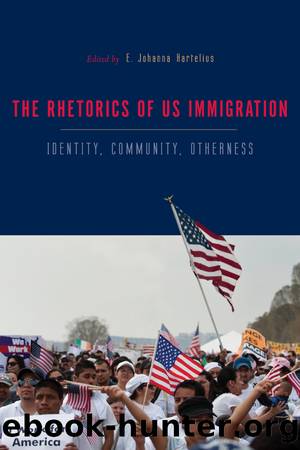The Rhetorics of US Immigration by Johanna Hartelius

Author:Johanna Hartelius
Language: eng
Format: epub
Publisher: The Pennsylvania State University Press
Notes
1. Beth Baker-Cristales, âMediated Resistance: The Construction of Neoliberal Citizenship in the Immigrant Rights Movement,â Latino Studies 7 (2009): 60â82.
2. See E. Johanna Hartelius, The Rhetoric of Expertise (Lanham, MD: Lexington Books, 2011).
3. William Keith and Paula Cossart, âThe Search for âRealâ Democracy: Rhetorical Citizenship and Public Deliberation in France and the United States, 1870â1940,â in Rhetorical Citizenship and Public Deliberation, ed. Christian Kock and Lisa S. Villadsen (University Park: Pennsylvania State University Press, 2012), 46. In this study, I use Keith and Cossartâs definition of rhetorical citizenship: âRhetorical citizenship is that set of communicative and deliberative practices that in a particular culture and political system allow citizens to enact and embody their citizenshipâ (46).
4. See Baker-Cristales, âMediated Resistance,â 78â79; Claudia A. Anguiano and Karma R. Chávez, âDREAMersâ Discourse: Young Latino/a Immigrants and the Naturalization of the American Dream,â in Latina/o Discourse in Vernacular Spaces: Somos de una Voz?, ed. Michelle A. Holling and Bernadette M. Calafell (Lanham, MD: Lexington Books, 2011), 81â99.
5. Tania A. Unzueta Carrasco and Hinda Seif, âDisrupting the Dream: Undocumented Youth Reframe Citizenship and Deportability Through Anti-Deportation Activism,â Latino Studies 12 (2014): 279â99.
6. Ibid., 279.
7. Robert Asen, âA Discourse Theory of Citizenship,â Quarterly Journal of Speech 90, no. 2 (2004): 191.
8. Ibid., 194.
9. Ibid., 203â4.
10. See Louis DeSipio and Rodolfo O. de la Garza, âA Nation of Immigrants: Continuing Dilemmas,â in Making Americans, Remaking America: Immigration and Immigrant Policy (Boulder: Westview Press, 1998), 4. When I refer to immigrants in this study, I mean people who move from one country and enter another, as DeSipio and de la Garza define the term.
11. See Leo R. Chavez, The Latino Threat: Constructing Immigrants, Citizens, and the Nation (Stanford: Stanford University Press, 2008).
12. Ibid., 2.
13. See P. J. Buchanan, The Death of the West: How Dying Populations and Immigrant Invasions Imperil Our Country and Civilization (New York: St. Martinâs Griffin, 2002); Jonathan Xavier Inda, âForeign Bodies: Migrants, Parasites, and the Pathological Nation,â Discourse 22, no. 3 (2000): 46â62; J. F. Perea, ed., Immigrants Out! The New Nativism and the Anti-Immigrant Impulse in the United States (New York: New York University Press, 1997); Otto Santa Ana, Brown Tide Rising: Metaphors of Latinos in Contemporary American Public Discourse (Austin: University of Texas Press, 2002).
14. Kent Wong et al., âPreface,â in Undocumented and Unafraid, ed. Kent Wong et al. (Los Angeles: UCLA Center for Labor Research and Education, 2012), xâxi.
15. Anguiano and Chávez, âDREAMersâ Discourse,â 81â82. The authors argue that social position is an important consideration when determining whether the normalization of the American Dream by undocumented youths resists hegemony.
16. Wayne Campbell Peck, Linda Flower, and Lorraine Higgins, âCommunity Literacy,â College Composition and Communication 46, no. 2 (1995): 199â222.
17. Anguiano and Chávez, âDREAMersâ Discourse.â
18. See Yvonne Watterson, ed., Documented Dreams: A Testimony of the Plight of a Generation of Young Latinos Caught in a Social Dilemma (Mesa, AZ: Hispanic Institute of Social Issues, 2008).
19. Ibid., 15.
20. Ibid., 11.
21. Robert Jensen, âRace Words and Race Stories,â in Jensen, The Heart of Whiteness: Confronting Race, Racism, and White Privilege.
Download
This site does not store any files on its server. We only index and link to content provided by other sites. Please contact the content providers to delete copyright contents if any and email us, we'll remove relevant links or contents immediately.
| Anthropology | Archaeology |
| Philosophy | Politics & Government |
| Social Sciences | Sociology |
| Women's Studies |
Born to Run: by Christopher McDougall(6893)
The Leavers by Lisa Ko(6802)
iGen by Jean M. Twenge(5161)
Sapiens by Yuval Noah Harari(5121)
The Kite Runner by Khaled Hosseini(4951)
Spare by Prince Harry The Duke of Sussex(4784)
Bullshit Jobs by David Graeber(3828)
Machine Learning at Scale with H2O by Gregory Keys | David Whiting(3612)
Livewired by David Eagleman(3534)
Never by Ken Follett(3520)
Goodbye Paradise(3444)
Fairy Tale by Stephen King(2942)
A Dictionary of Sociology by Unknown(2849)
Harry Potter 4 - Harry Potter and The Goblet of Fire by J.K.Rowling(2799)
The Social Psychology of Inequality by Unknown(2759)
The Club by A.L. Brooks(2745)
People of the Earth: An Introduction to World Prehistory by Dr. Brian Fagan & Nadia Durrani(2619)
0041152001443424520 .pdf by Unknown(2592)
Will by Will Smith(2575)
